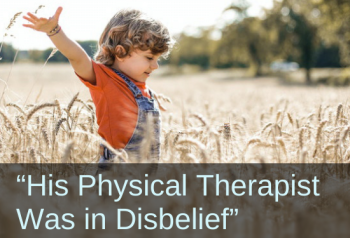OT Uses Playful Reflex Integration to Help Boy with DCD
Submitted by Mary McKevitt, MS, OTR/L

|
Before
|
After
|
|
Poor coordination
|
Moving in a much more coordinated fashion
|
|
Very low muscle tone
|
Improved strength
|
|
Challenges assuming and maintaining quadruped
|
Able to independently assume and maintain quadruped for more than 1 minute, and play in that position as well
|
|
Poor gross motor skills
|
Improved motor planning
|
Client is a 4-year-old boy who is diagnosed with developmental coordination disorder. He has a history of Torticollis, which was never treated by a therapist as his pediatrician said treatment is optional for that diagnosis. He now presents with subsequent very low muscle tone, decreased coordination, spatial awareness, decreased fine motor and gross motor skills. I chose to utilize the 5-Step Balance Process [from the Brain and Sensory Foundations course] with this client as he presents with a likely unintegrated ATNR and STNR reflex.
Due to focusing on both ATNR and STNR reflex integration along with the 5-Step Balance Process, I used quite a bit of tools within this course including: playful ATNR Reflex Integration Activities (belly crawl with stuffed animal ride), playful STNR Reflex Integration Activities cross crawls and drinking water.
My client is high functioning cognitively and was able to create his own goal of shooting a basket. Therefore, we said his goal out loud together a couple of times: “I am shooting a basket into the hoop.”
We made his goal super exciting to the point in which on his own he would repeat his goal to me throughout our session. The ATNR and STNR reflex integration activities were chosen to reduce atypical movement patterns associated with these reflexes in which my client retained.
During the session my client was very adamant about his goal. This alone I felt was very helpful in engaging him throughout. Typically he becomes fatigued quickly, but I feel as though having this goal set allowed for him to persevere more throughout these sessions and did he did not fatigue or request for breaks as often. The most improvement I had noted within this approach was definitely my client’s ability to not only sustain quadruped, but to actively engage in the STNR puppy stretches [from the Brain and Sensory Foundations course] for significantly longer. I was hesitant to even include STNR integration into the 5-step balance process knowing I needed to work on ATNR first, but I am glad I did as I saw the most results within STNR integration post finishing this process. Initially my client was unable to remain in quadruped for more than 30 seconds at a time. [We worked up to] my client being able to maintain quadruped with his elbows unlocked, but for no longer than a minute at a time. We had been working on building his tolerance through Rhythmic Movements [from the Brain and Sensory Foundations course] (at home with parents and with me). Even my clinic’s Physical Therapist who treats this same client was in disbelief watching my client complete the puppy stretches from the beginning of the month to the end of the month (4-week span, 1x a week frequency) in which 5-Step Balance Process was completed. By the end of this process, my client was able to not only sustain quadruped for more than 1 minute, but play in that position and independently assume it as well, which was not the case only months prior. Ultimately my client required multiple attempts and accommodations via stepping closer, using a lighter ball and lowering the hoop to shoot his basket into the hoop but he was thrilled to be successful within his goal.
I learned a lot from this experience, I was hesitant to work on multiple reflexes at the same time. But I am very glad I did this 5-Step Balance Process as it really highlighted to me how much the reflexes and integration process overlap with one another. I was so happy to see progression on my client’s STNR reflex while also working on his ATNR reflex as well. From my limited knowledge regarding reflexes prior to this [Brain and Sensory Foundations] course, I assumed that reflex integration consisted of finding the one reflex the child had that is unintegrated and to then place that child into that position via exercises repeatedly. However, this course and process with this client opened my eyes to how much more functional and playful reflex integration is. I was so happy to see my client’s results. We have continued to incorporate Rhythmic movements, ATNR/STNR integration activities and Brain Tune-Ups with this client. He is moving in a much more coordinated fashion with improvements with his strength and motor planning as well!
(Edited, emphasis added)


